Blood sausage: Difference between revisions
m Reverted 1 edit by 213.106.226.245 identified as vandalism to last revision by Joshii. using TW |
Gibmetal77 (talk | contribs) m infobox |
||
| Line 1: | Line 1: | ||
| ⚫ | |||
{{for|the Dungeons & Dragons monster|Black pudding (Dungeons & Dragons)}} |
{{for|the Dungeons & Dragons monster|Black pudding (Dungeons & Dragons)}} |
||
{{Refimprove|date=December 2007}} |
{{Refimprove|date=December 2007}} |
||
{{Infobox Prepared Food |
|||
| name = Black pudding |
|||
| ⚫ | |||
| caption = [[Boudin|Black pudding (Boudin noir)]], before cooking |
|||
| alternate_name = Blood pudding<br>Morcilla<br>Boudin noir |
|||
| country = |
|||
| region = |
|||
| creator = |
|||
| course = |
|||
| served = Hot or cold |
|||
| main_ingredient = [[Blood as food|Blood]] |
|||
| variations = |
|||
| calories = |
|||
| other = |
|||
}} |
|||
'''Black pudding''' or (less often) '''blood pudding''' is a British English term for [[sausage]] made by [[blood as food|cooking blood]] with a filler until it is thick enough to congeal when cooled. It is also called '''blood sausage''' (first attested in 1868, perhaps influenced by German ''Blutwurst''). Although "blood sausage" is often labeled as a [[North America]]n term, it is also found in British English (e.g., in the story "The Name-Day" by [[Saki]]). "Blood sausage" is also a useful term for similar blood-based solid foods around the world. |
'''Black pudding''' or (less often) '''blood pudding''' is a British English term for [[sausage]] made by [[blood as food|cooking blood]] with a filler until it is thick enough to congeal when cooled. It is also called '''blood sausage''' (first attested in 1868, perhaps influenced by German ''Blutwurst''). Although "blood sausage" is often labeled as a [[North America]]n term, it is also found in British English (e.g., in the story "The Name-Day" by [[Saki]]). "Blood sausage" is also a useful term for similar blood-based solid foods around the world. |
||
[[Pig]] or [[cattle]] blood is most often used; [[sheep]] and [[goat]] blood are used to a lesser extent. Blood from [[poultry]], [[horse]]s and other animals are used more rarely. Typical fillers include [[meat]], [[fat]], [[suet]], [[bread]], [[sweet potato]], [[barley]] and [[oatmeal]]. |
[[Pig]] or [[cattle]] blood is most often used; [[sheep]] and [[goat]] blood are used to a lesser extent. Blood from [[poultry]], [[horse]]s and other animals are used more rarely. Typical fillers include [[meat]], [[fat]], [[suet]], [[bread]], [[sweet potato]], [[barley]] and [[oatmeal]]. |
||
==Regional variants== |
==Regional variants== |
||
Revision as of 00:12, 10 October 2008
This article needs additional citations for verification. (December 2007) |
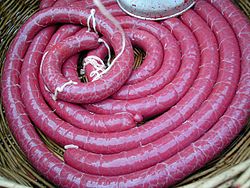 Black pudding (Boudin noir), before cooking | |
| Alternative names | Blood pudding Morcilla Boudin noir |
|---|---|
| Serving temperature | Hot or cold |
| Main ingredients | Blood |
Black pudding or (less often) blood pudding is a British English term for sausage made by cooking blood with a filler until it is thick enough to congeal when cooled. It is also called blood sausage (first attested in 1868, perhaps influenced by German Blutwurst). Although "blood sausage" is often labeled as a North American term, it is also found in British English (e.g., in the story "The Name-Day" by Saki). "Blood sausage" is also a useful term for similar blood-based solid foods around the world.
Pig or cattle blood is most often used; sheep and goat blood are used to a lesser extent. Blood from poultry, horses and other animals are used more rarely. Typical fillers include meat, fat, suet, bread, sweet potato, barley and oatmeal.
Regional variants
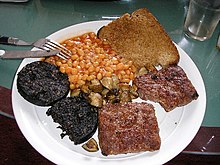
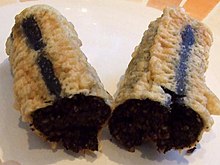
Black pudding is usually served as part of a traditional full breakfast in England, Scotland and Ireland. The further addition of the similar white pudding is an important feature of the traditional Irish breakfast and is also common in Scotland. Black pudding can be eaten uncooked but is often grilled or boiled in its skin.
The Greater Manchester town of Bury is noted for its black pudding, as is Ireland's south west County Cork town of Clonakilty, which exports black pudding as a delicacy item. One of Co. Clare's iconic foods is Bonina Black Pudding. Originating from Miltown Malbay in the west of the county, it is made using traditional methods and is less processed than better known brands. Black and white pudding, as well as a third variant from Fife: – red pudding – are served battered at chip shops in Scotland and England as an alternative to fish and chips.
Continental Europe
The most common variant of German Blutwurst is made from pork rind, pork blood and filler such as barley. Though already cooked and "ready to eat" it is usually served warm. In the Rhineland, where it is also traditionally made from horse meat, fried Blutwurst is a part of various dishes. Another German variant is Zungenwurst, which is Blutwurst mixed with pieces of pickled pig's tongue.
A variety of Blutwurst, the Rotwurst from Thüringia (Thüringer Rotwurst) has geographical indication protection under EU law, with PGI status.
In France boudin is a traditionally prepared by a charcuterie, the shops that mainly prepare pork products (but also duck and game), also selling smoked and dried sausages, pâtés, and terrines, along with prepared salads. It may also be called boudin noir and often has apples or onions as a filler. It is always served with either cooked apples, mashed potatoes or both, and is appreciated by combining either the apples or mashed potatoes with each bite of boudin, which has been gently heated and browned in butter. In France also, there are many regional different Boudins Noirs' such as the large 'Boudin du Béarn with pork meat pieces eaten usually cold.
In Belgium, bloedworst or beuling is sold either in 4 inch diameter slices, or individual sausages the size of a banana. It is generally pan fried; sometimes apples are cooked alongside or on top of the pieces. It is also eaten with apple sauce, brown sugar or syrup.
In Iceland, blóðmör is the one of two types of slátur. Usually boiled in its skin and eaten hot. Also fried but usually the day after it is boiled (as leftovers).
Similarly Czech jelito is made from pork, pig's blood and groats; the stuffing served by itself, unformed is called prejt.
Spanish morcilla has many variants. The most well known and widespread is "morcilla de Burgos" which mainly contains pork blood and fat, rice, onions, and salt. In Albacete and La Mancha the morcilla is filled with onions instead of rice, which completely changes the texture. It is claimed that this is the original morcilla and rice was introduced in them to reduce costs (rice expands while onion reduces thus needing more raw material). Other varieties introduce breadcrumbs, pine nuts, almonds and vary the proportions of the other ingredients or flavorings, producing even a sweet morcilla from Galicia in the northwestern region, which is fried and served most commonly as a dessert.
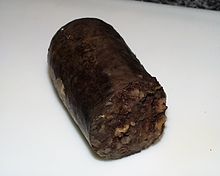

In Portuguese cuisine there are also many varieties of black pudding, ranging from some similar to the Spanish morcilla, known in Portuguese as morcela, to some done only with blood (known as chouriço de sangue).
In Romania, the traditional and tasty sangerete (from "sange", the Romanian for blood) is made from Shoulder Butt pork meat, pork blood and filler such as pre-boiled rice, seasoned with pepper, garlic and basil. It has many regional variants, but the most common are the "sangerete" from Transsylvania.
In Eastern Europe, kishka is made with pig's blood and buckwheat kasha, it is also known in Russia as krovyanka (кровянка) or krovyanaya kolbasa (кровяная колбаса, blood sausage) and Poland (Central Europe) as kaszanka. Polish black and brunshwick salceson are a types of head cheese which contains blood. In Hungary, véres hurka is made with rice, pig's blood and pork. In Bulgaria karvavitsa (кърваваица) is usually prepared with pig's blood, fat and a variety of mountain herbs and spices and eaten warm during the winter.
Blodpudding is popular in Sweden, and there are variants such as blodkorv (blood sausage), blodplättar (blood pancakes) and blodpalt. There is also a soup made from blood, called svartsoppa (black soup). One traditional way of serving blood pudding in Sweden is with bacon, cabbage, and lingonberry jam.
Alongside the mustamakkara (black sausage) in Finland, a dish similar to black pudding is made by making batter out of pig's blood and baking it like pancakes. Traditionally rye- or oatflour is used and minced onion is added to the mix. This dish is called veriohukainen (blood pancake). It is similar to the Swedish dish blodplättar above, and is alternatively called veriletut (using a Finland-Swedish term for pancakes instead of a native Finnish one). A dish similar to Swedish svartsoppa is a straditional North-Finnish soup made of bloodpudding rössypottu.
In Estonia, verivorst (blood sausage) is very similar to Finnish mustamakkara. It is sold and eaten mostly in winter, being a traditional Christmas food. At that time there is a large variety of verivorst in stores, ranging in different shapes and sizes, sometimes also rolled in bacon. Verivorst is usually cooked in an oven, but sometimes also fried on pan. Like in Finland, verivorst is often eaten together with lingonberry jam, but occasionally also with butter or sour cream. Another similar dish is called verikäkk (blood dumpling). Its popularity has decreased during the past decades (possibly because of its less appealing commercial appearance) and has mostly been substituted by verivorst.
The Americas

Among English-speaking North Americans, the consumption of black pudding and similar dishes is largely confined to certain ethnic groups with strong Old World traditions as well as French Canadians and recent immigrants from Great Britain, Ireland, Australia, and so forth. Blood sausages are very difficult to find in American supermarkets. Brussels, WI and Sturgeon Bay, WI are both home to local grocers who produce blood sausage, due to their large Belgian populus.
An Italian-American version of black pudding in the San Francisco Bay area is called "Biroldo" and has pine nuts, raisins, spices, pig snouts and is made using either pig blood or cow's blood.
Cajun boudin is a fresh sausage made with green onions, pork, livers (usually chicken), and rice; pig's blood is sometimes added to produce "boudin noir".
In many areas of Latin America (as in Spain) morcilla is served. Morcilla is sometimes made with a filler of rice and/or onions, and seasoned with paprika and other spices. In Puerto Rico it is made spicy-hot and served fried. In parts of South America, morcilla is a traditional component of the asado, a regional mixed grill or barbecue meal. Morcilla is also eaten inside a sandwich called "morcipán," especially in Argentina and other Río de la Plata countries; in Uruguay, although not in Argentina, a sweet and sour version including raisins and pine nuts is popular. In Chile it's called prieta. In Panama and Colombia, it's called morcilla, rellena or tubería negra, and is usually filled with rice and peas. Contrary to beliefs, this version is usually deep-fried, and it is quite popular.
In Guyana, the main ingredient in black pudding is cooked rice seasoned with traditional Caribbean herbs, such as thyme and basil. The rice is mixed with cow's blood, stuffed into Cow or Pig intestine, and boiled until firm. It is served as an appetizer or snack, often with any type of hot sauce, mild to hot, depending on preference and regional area.
In Suriname, black pudding is also known under the Dutch name bloedworst, and white pudding under the also Dutch name vleesworst.
Asia
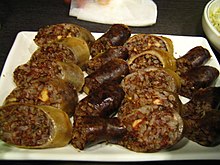
Across Asia, various people create foods from congealed animal blood. Most of these foods do not have casing and might be considered a version of sliced sausage.
In Taiwan, pig blood cake (Chinese: 豬血糕; pinyin: zhū xiě gāo) is made of pork blood and sticky rice. It is fried or steamed as a snack or cooked in a hot pot.
A similar dish from the Philippines, dinuguan (from the word dugo meaning "blood") (pork-blood stew) is a stew consisting of diced beef or pork meat and organs with pig or cow blood simmered in a rich, spicy gravy of pig blood, garlic, chili and vinegar. Because many non-Filipinos find the dish revolting, the euphemism "chocolate meat" was coined. Dinuguan is often served with white rice or a Filipino rice cake called puto.
In China, "blood tofu" (Chinese: 血豆腐; pinyin: xuě dòufǔ), is most often made with pig's or duck's blood, although chicken's or cow's blood may also be used. Like the above dishes, this has no casing but is simply cut into rectangular pieces and cooked. This dish is also known in Java as saren, made with chicken's or pig's blood.
In resource-poor Tibet, congealed yak's blood is a traditional food.[1]
The majority of Korea's soondae (순대) can be categorized as blood sausage. The most common type of soondae is made of potato noodle (dangmyeon), barley, and pig's blood but some variants contain sesame leaves, green onion, fermented soy paste (doenjang), sweet rice, kimchi, bean sprouts, in addition to the common ingredients.
Vietnamese 'dồi tiết'(Northern) or 'dồi huyết' (Southern) is blood sausage, boiled or fried, made with pork blood, pork fat, basil.
Additional varieties
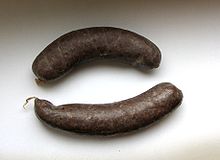
Other varieties of blood sausage include blodpølse (Norway and Denmark), boudin noir (France), tongeworst (with added pigs tongues) (Netherlands), zwarte pens or beuling (Belgium), blóðmör (Iceland), boudin rouge (Creole and Cajun), morcela and chouriço de sangue (Portugal), morcilla (Spain and Latin America), krvavica (Bulgaria, Croatia, Serbia, Slovenia), sângerete (Romania), prieta (Chile), rellena or moronga (Mexico), dồi (Vietnam), sanganel (Friuli), ragati (Nepal) and kaszanka (Poland).
Art
Members of the group monochrom prepared blood pudding out of their own blood and ate it. The performance (staged in 2003 in Vienna) was accompanied by political essays about the 'autocannibalistic' tendencies of the global economy. The event, called "Viennese Factionism: Auto-Blood-Sausage", also can be interpreted as a critical statement about art, art history and the art market (Viennese Actionism). ORF FM4, Arte
See also
- Full Breakfast
- Breakfast Roll
- Square sausage
- White pudding
- Blood soup
- Commonwealth Black Pudding Throwing Championships
References
- ^ Ma Jian, Stick Out Your Tongue Chatto and Windus London, 2006.
